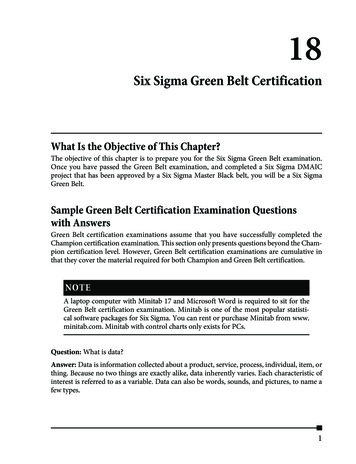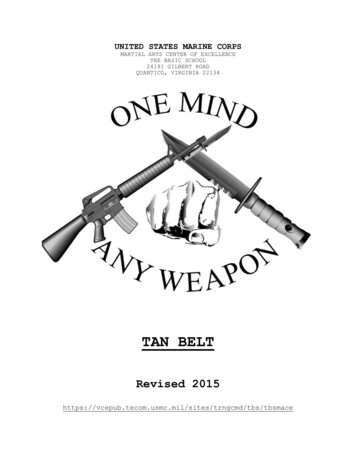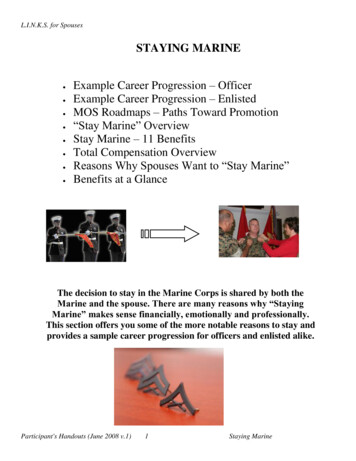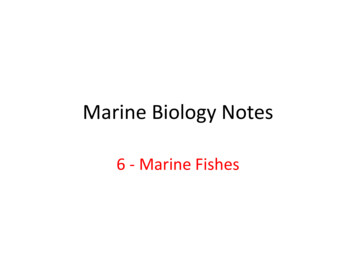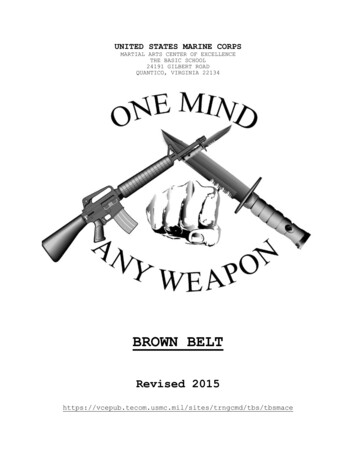
Transcription
UNITED STATES MARINE CORPSMARTIAL ARTS CENTER OF EXCELLENCETHE BASIC SCHOOL24191 GILBERT ROADQUANTICO, VIRGINIA 22134BROWN BELTRevised s/tbsmace
TABLE OF CONTENTSLesson IDLesson TitlePage #MCCS-BRWN-2041BAYONET TECHNIQUES.3MCCS-BRWN-2042GROUND ROWS.31MCCS-BRWN-2045UNARMED VERSUS HANDHELD WEAPONS.39MCCS-BRWN-2046FIREARM RETENTION.47MCCS-BRWN-2047KNIFE TECHNIQUES.57MCCS-BRWN-2048FIREARM DISARMAMENT.65MCCS-BRWN-2049WARRIOR AS A GENTLEMAN.75MCCS-BRWN-2050MARTIAL CULTURE STUDY: THE APACHES.79MCCS-BRWN-2051FREE SPARRING.87GUIDED DISCUSSION 1:FINANCIAL RESPONSIBILITY.103GUIDED DISCUSSION 2:THE OATH OF ENLISTMENT.111GUIDED DISCUSSION 3:LAWS OF WAR.119GUIDED DISCUSSION 4:WARRIOR MORAL ETHIC.1331
MCCS-BRWN-20412
MCCS-BRWN-2041UNITED STATES MARINE CORPSMARTIAL ARTS CENTER OF EXCELLENCETHE BASIC SCHOOL24191 GILBERT ROADQUANTICO, VIRGINIA 22134LESSON PLANBAYONET TECHNIQUESMCCS-BRWN-2041BROWN BELTAPPROVED BY:LtCol (Ret) Shusko, J. C.3DATE: 07/31/2015
MCCS-BRWN-2041UNITED STATES MARINE CORPSMARTIAL ARTS CENTER OF EXCELLENCETHE BASIC SCHOOL24191 GILBERT ROADQUANTICO, VIRGINIA 22134INSTRUCTOR PREPARATION GUIDELESSON TITLE:LESSON DESIGNATOR:Bayonet TechniquesMCCS-BRWN-2041TOTAL LESSON TIME:2 hoursREFERENCES:MCO 1500.59NAVMC 3500.41MCRP 3-02BPERSONNEL REQUIRED:One instructor and assistantsFACILITIES:Soft footed training areaREVIEW COURSE MATERIALS: Review Lesson PlanADD PERSONALIZATION: Personalize the lesson by adding subject matter detail,personal experiences, examples, and questions.MATERIALS/EQUIPMENT: Rifle/Training Rifle Bayonet Trainer Wooden Bayonet Trainer Flak Jacket Helmet MouthpieceSETUP AND PLANNING: Reserve Training Area Conduct Rehearsals4
MCCS-BRWN-2041INTRODUCTION(5 MIN)1.GAIN ATTENTION. As Marines we are constantly training tofight America’s battles. The fighting that took place in battleslike Bloody Ridge, Bairoko, and Okinawa was “Close-In” fighting.The fighting consisted of grenades, firing rounds while closing,bayonets and even knives. During these engagements Marines wereconfronted by multiple attackers and engagements. The techniquesthat we will learn today were utilized by those Marines in suchbattles. These skills are some of the many elements needed tomaintain combat readiness.2. OVERVIEW. Good morning, my name is . This lessonwill cover bayonet techniques and the combat readiness.3.POSITIONSINSTRUCTOR NOTE: Assign demonstration and practice positions.Ensure students have enough space, and can see and hear theinstructor.4.SAFETY.To prevent injury, ensure the following:a.Start slowly and increase speed with proficiency.b.Never execute techniques at full force or full speed.c.Training will be conducted in three stages.(1) Marines will execute techniques in the air.(2) Marines will practice strikes on a pad or dummy.(3) Marines will practice during free sparring.d.Before training with firearms, unload and show clear.e.When handling firearms, the weapons safety rules apply.(1) Treat every weapon as if it were loaded.(2) Never point a weapon at anything you do not intend toshoot.(3) Keep your finger straight and off the trigger untilyou are ready to fire.(4) Keep your weapon on “safe” until you intend to fire.f. Conduct all practical application utilizing approvedtraining gear.5
MCCS-BRWN-2041TRANSITION. Now that you know what will be covered are there anyquestions? Let’s discuss the purpose of bayonet techniques.BODY1.(45 MIN)EXPLAINa. Purpose. The purpose of bayonet techniques is to disableor kill an aggressor.b. Principles. The principles for bayonet techniques aremindset, grip, stance, movement, and channeling.(1) Mindset. When engaged, your mindset is a factor ofsuccess or failure. Mindset is the "mental trigger" during adefining moment that enables you to commit to an attack. Youmust have the superior mindset against the aggressor to succeed.(2) Grip. It is possible to execute these bayonettechniques while gripping the buttstock of the weapon, but thestress is on being able to execute them from the pistol grip.These are lethal, offensive techniques that can be used inconjunction with assault fire movement.(a) Grab the pistol grip with your right hand. Keepyour trigger finger off the trigger and included it in the grip.(b) With the left hand, grab the hand guards of therifle under-handed.(c) Lock the buttstock of the rifle against the hipwith the right forearm.(d) Keep movements of the bayonet blade within a box,shoulder width across from your neck down to your waistline.Always keep the bayonet end of the rifle oriented toward theaggressor.(3) Stance. All movement begins and ends with themodified basic warrior stance. Create a smaller silhouette andlower center of gravity by lowering your body at the knees andcreate “eye-muzzle-target” toward the aggressor.(4) Movement. Movement is used to get from one place toanother when the threat of contact is imminent. Use a controlledand steady combat glide to avoid tripping while moving toward theaggressor.(5) Channeling. Channeling is using movement to placeone aggressor in front of the other. This will allow you to6
MCCS-BRWN-2041engage one aggressor at a time. Using the proper angles ofapproach learned earlier in your martial arts training does this.c. Fundamentals. The fundamentals for bayonet techniquesare approach, close, and entry.(1) Approach. Approaching is used when you have locatedthe aggressor. While maintaining a combat glide, move toward theaggressor until you are within 5 to 10 feet. The bayonet muststay locked on the aggressor.(2) Close. As you reach the critical distance of 5 to 10feet, you will use a burst of speed to close the final distancewith the aggressor. Increase your speed by quickening your stepswithout changing your stride length or standing upright. Thiswill cause the aggressor to hesitate and give you thepsychological and tactical advantage.(3) Entry. The entry is made to get inside theaggressor’s defense to conduct a lethal attack. The movement canbe a step forward or to an oblique to get within range.(a) Target Areas. The primary target areas of thebody are the aggressors throat, groin, or face. The aggressor’storso can be another target area if it is not protected by bodyarmor.(b) Striking Surface. Thrusts will use the point ofthe bayonet and slashes will use the cutting edge of the bayonet.Buttstrokes will use the toe of the buttstock off the rifle andsmashes will use the butt of the rifle.TRANSITION: We have covered the purpose, principles, andfundamentals, are there any questions? I will now demonstratethe first technique.2.DEMONSTRATEINSTRUCTOR NOTE: Demonstrate only one technique at a time.Do not explain the steps or open the class for questions.INTERIM TRANSITION:3.Go to practice position one.IMITATEa. One-On-Two Engagement. This technique is used to isolateeach aggressor to allow you to fight them one at a time.(1) Assume the modified basic warrior stanceapproximately 30 to 40 feet away from two aggressors staggered7
MCCS-BRWN-2041approximately 10 meters in stationary positions, as depictedbelow.(2) While moving toward aggressor, use angles of approachto place one aggressor in front of the other, as depicted below.(3) Use an economy of motion and no hesitation whilemoving towards aggressors.(4) Utilize natural terrain features and/or obstacles tochannel aggressors along with movement.(5) Engage one aggressor at a time.any time.Do not hesitate at(6) Primary technique used is the straight thrust, unlessa disrupt is needed to disrupt your aggressor.(7) When at closing distance, thrust bayonet to engagethe aggressor at the furthest possible distance.b. Two-On-One Engagement. This technique is used to allowtwo Marines to simultaneously attack one aggressor.(1) Two Marines assume the modified basic warrior stanceapproximately 20 to 30 feet away from one aggressor in astationary position, as depicted below.8
MCCS-BRWN-2041(2) Execute movement toward the aggressor. Do not allowthe aggressor to use angles of approach to place one Marine infront of the other.(3) Stay together in a manner that allows both Marines toattack simultaneously, covering each other’s movement and attack.This is accomplished by staying shoulder to shoulder untilclosing, then attacking at a ninety-degree angle to each other.Communication between the Marines is essential.(4) Use an economy of motion and no hesitation whilemoving towards the aggressor.(5) Utilize natural terrain features and/or obstacles tocanalize the aggressor along with movement.(6) Primary technique used is the straight thrust, unlessa disrupt is needed to clear a path for your blade.c. Two-On-Two Engagement. This technique is used to allowtwo Marines to isolate each aggressor, allowing you to fight themone at a time.(1) Two Marines assume the modified basic warrior stanceapproximately 30 to 40 feet away from two aggressors staggeredapproximately 10 meters in stationary positions, as depictedbelow.(2) While moving towards the aggressors use angles ofapproach to place one aggressor in front of the other. At thesame time do not allow the aggressors to use angles of approachand movement to place one Marine in front of the other.(3) Stay together in a manner, which will allow bothMarines to attack one aggressor at a time, covering each other’smovement and attack. This is accomplished by staying shoulder to9
MCCS-BRWN-2041shoulder until closing, then attacking at a ninety-degree angleto each other. Communication between the Marines is essential.Do not allow the aggressors to turn this into two, one-on-oneengagements.(4) Use an economy of motion and no hesitation whilemoving towards aggressors.(5) Utilize natural terrain features and/or obstacles tochannel aggressors along with movement.(6) Engage one aggressor at a time.any time.Do not hesitate at(7) Primary technique used is the straight thrust, unlessa disrupt is needed to disrupt your aggressor.(8) When at closing distance, thrust bayonet to engagethe aggressor at the furthest possible distance.4.PRACTICEINSTRUCTOR NOTE: Fault check student proficiency and safety.TRANSITION: We have learned bayonet techniques, are there anyquestions? We must also be maintain combat readiness.5.TIE-IN (COMBAT READINESS). Every individual Marine isessential to the performance of his unit, and all Marine unitsdepend upon the effective performance of other units. A loss ineffectiveness can result in the loss of Marine lives. EveryMarine must know how to do his job; this translates into uniteffectiveness. But effectiveness is not necessarily combatreadiness. Combat readiness is effectiveness plus the desire andability to keep on fighting until the mission is accomplished.Simply put it is the ability to maintain efficient and effectiveperformance while under enemy fire; to fight and win. Theobjective of Marine Corps training is combat readiness.10
MCCS-BRWN-2041a.How To Achieve Combat Readiness(1) Building unit discipline, proficiency, morale, andesprit de corps.(2) Training to enhance each Marine's knowledge of thejob, self-discipline, self-confidence, and leadership.(3) Discipline, proficiency, morale, and esprit de corpsare leadership indicators that are dealt with in some detail asleadership challenges. They are reflections of the willpower ofthe individuals in the unit and are crucial to combat readiness.We will now focus on the training concepts that contribute to aunit's ability to succeed in combat.b. How To Prepare Our Marines. "The great majority ofsoldiers overcome fear, as they have done throughout their lives,by an effort of will and by support from others." Why is this?Where/how can we instill the "will?" How do we ensureindividuals will receive the needed support? Some suggestionsare:(1) Develop a close knit and cohesive group.(2) Avoid personnel turbulence.(3) Know your Marines and be known by them.(4) Promote and retain only the finest leaders.(5) Train your Marines as they will be employed and asnearly accurate to a combat environment as possible.(6) Ensure all are physically fit.(7) Train to ensure competent administration, logistics,and communication.(8) Train on how to identify and cope with combatstresses.(9) Provide realistic and stressful training to buildproficiency and confidence in leaders, unit, equipment, tactics,weapons, and self.(10) Provide firm fair discipline but ensure that youemphasize and recognize superior performance.(11) Cross train to ensure depth in unit proficiency andleadership.11
MCCS-BRWN-2041c.Marines Must Train The Way They Intend To Fight.(1) Realistic Training. Combat training must bestressful and incorporate noise, smoke, danger, confusion, andfatigue if it is to be moderately effective. The conditionsthat are anticipated must be duplicated as much as possible. Intraining exercise your ability to handle everything you expectto handle in combat. Carry heavy loads; go on forced marches;conduct low-level flight training; operate without supplies onoccasion to simulate the necessity of sharing rations, water,and ammunition; practice care for casualties; and developphysical strength and endurance to the level where everyone hasconfidence in their ability to persevere. Use your imagination;it is the responsibility of the leader to prepare the minds ofMarines for the shock of combat. Captain Von Schell said itbest in Battle Leadership:In peace we should do everything possible toprepare the minds of our soldiers for the strainof battle. We must repeatedly warn them that warbrings with it surprise and tremendously deepimpressions.We must prepare them for the factthat each minute of battle brings with it a newassault on the nerves. As soldiers of the future,we should strive to realize that we will be facedin war by many new and difficult impressions;dangers that are thus foreseen are already halfovercome.(2) Train in the basic fundamentals. Emphasizecamouflage; cover and concealment; helo operations; movement;preparation of battle positions; accuracy, control, anddistribution of fire; use of supporting arms; land navigation;communicating with and without radios; noise and lightdiscipline; and other basic skills. All are essential elementsthe combat leader must teach Marines so they can survive on thebattlefield.(3) Training should emphasize the attack. We don't winby defending. Defense is something that is only accomplishedwhen we are preparing to continue the attack. Even whendefending, aggressive patrol actions should take the fight to theenemy, and familiarize him with what he can expect if he electsto attack. Instinctively think of forward movement and instill adesire to close with and destroy the enemy. Concentrate on dayand night offensive operations.(4) Training should develop an aggressive spirit andconfidence in the fighting ability of the individual and theunit. Emphasize close combat training. A Marine should be anexpert in unarmed combat and be able to skillfully fight with theknife and bayonet. These skill areas require extensive training12
MCCS-BRWN-2041to master requisite speed and technique for effective use, but itis worth it and Marines thrive on it. Hand-to-hand combattraining, bayonet training, unit events such as bear pits, pushball, or other physical team oriented efforts develop confidenceand aggressive spirit.(5) Cross training is essential. All Marines must notonly be able to perform their individual jobs, they must know howto keep the unit operating at peak efficiency. This meansknowing one another's job and being able to keep the essentialequipment/weapons operating when combat power is crucial. Crosstraining is a key element for maintaining cohesion when takingcasualties. All Marines must understand instinctively that theirfirst responsibility in combat is to join their force to others;the unit must prevail. Only through effective control of unitfirepower can combat success be attained. Cross training willalso develop a depth of leadership ability that will allow forthe continued effectiveness of the unit if any leader becomes acasualty. Train all your Marines to be ready and able to takecharge and make decisions if their leader is taken out.(6) Train under adverse conditions. Combat will testyour ability to endure hardship. Marines must be conditioned towithstand the effects of weather. Recall the experience ofCaptain Barrow in Korea. Extreme weather conditions offer adistinct advantage to the side best prepared to continue fightingamidst such hardships. Training in adverse weather will buildconfidence in your Marines' ability to care for weapons,equipment, and themselves. Remember, merely enduring is notenough; they must be able to use adverse conditions to theiradvantage to fight.(7) Drill is the beginning of the process that turns anuncoordinated group of individuals into a tight military unit.Drill produces a habit of prompt obedience to orders and instillspride, a sense of unity, and discipline. The habit ofresponsiveness that is developed through drill will help carrythe unit through the terrifying moments when the shock of enemyfire is first felt.TRANSITION:questions?We have discussed combat readiness, are there anySUMMARY(10 MIN)During this period of instruction we have covered bayonettechniques and combat readiness. I am now confident you will beable to use these techniques to kill the enemy if necessary.INSTRUCTOR NOTE: Provide follow-on instructions.13
MCCS-BRWN-204114
MCCS-BRWN-2042UNITED STATES MARINE CORPSMARTIAL ARTS CENTER OF EXCELLENCETHE BASIC SCHOOL24191 GILBERT ROADQUANTICO, VIRGINIA 22134LESSON PLANGROUND FIGHTINGMCCS-BRWN-2042BROWN BELTAPPROVED BY:LtCol (Ret) Shusko, J. C.15DATE: 08/10/2015
MCCS-BRWN-2042UNITED STATES MARINE CORPSMARTIAL ARTS CENTER OF EXCELLENCETHE BASIC SCHOOL24191 GILBERT ROADQUANTICO, VIRGINIA 22134INSTRUCTOR PREPARATION GUIDELESSON TITLE:Ground FightingLESSON DESIGNATOR:MCCS-BRWN-2042TOTAL LESSON TIME:1 hour 30 minutesREFERENCES:MCO 1500.59NAVMC 3500.41MCRP 3-02BPERSONNEL REQUIRED:One instructor and assistantsFACILITIES:Soft footed training areaREVIEW COURSE MATERIALS: Review Lesson PlanADD PERSONALIZATION: Personalize the lesson by adding subject matter detail,personal experiences, examples, and questions.MATERIALS/EQUIPMENT: MouthpieceSETUP AND PLANNING: Reserve Training Area Conduct Rehearsals16
MCCS-BRWN-2042INTRODUCTION(5 MIN)1. GAIN ATTENTION. Anything is possible on the battlefield andif you should end up fighting an aggressor on the ground, youmust be prepared for it. Ground fighting techniques will allowyou to fight and aggressor and get back to your feet. There aremany skills we must maintain to be a positive citizen.2. OVERVIEW. Good morning, my name is .will cover ground fighting and citizenship.3.This lessonPOSITIONSINSTRUCTOR NOTE: Assign demonstration and practice positions.Ensure students have enough space, and can see and hear theinstructor.4.SAFETY.To prevent injury, ensure the following:a.Start slowly and increase speed with proficiency.b.Never execute techniques at full force or full speed.c.Techniques will be performed on a soft-footed area.d. Apply slow, steady pressure until the aggressor taps out.Aggressor will tap out when they become uncomfortable. They maytap the deck, tap themselves, tap the Marine, or verbally say“tap-tap-tap.” The Marine must immediately release the pressurewhen the aggressor taps out.TRANSITION. Now that you know what will be covered are there anyquestions? Let’s discuss the purpose of ground fighting.BODY1.(75 MIN)EXPLAINa. Purpose. The purpose of ground fighting is to get backto your feet as quickly as possible.b. Principles.and control.The principles for ground fighting are space(1) Space. Create space in order to execute techniquesthat will disable the aggressor allowing you to get back to yourfeet. Too much or too little space can give the aggressor theadvantage.17
MCCS-BRWN-2042(2) Control. Control the aggressor in order to limit hismovement and ability to damage you. Take away the aggressor’sspace to reduce his ability to fight.c. Fundamentals. The fundamentals for ground fighting arethe mount position and guard position. Both positions areoffensive if you know techniques to give yourself the tacticaladvantage.(1) Mount Position. In this position the aggressor is onthe ground and you are on top. Your legs are outside theaggressor’s hips, controlling his ability to move. This is anoffensive position because you are able to control the aggressorand to execute ground fighting techniques. The side mountposition is a variation of the mount.(2) Guard Position. In this position you are on theground and the aggressor is on top of you, but your legs arewrapped around his waist. This is also an offensive positionbecause you control your aggressor’s movement and execute groundfighting techniques.TRANSITION: We have covered the purpose, principles, andfundamentals, are there any questions? I will now demonstratethe first technique.2.DEMONSTRATEINSTRUCTOR NOTE: Demonstrate only one technique at a time.Do not explain the steps or open the class for questions.INTERIM TRANSITION:3.Go to practice position one.IMITATEa. Bent Armbar from Side Mount. This technique is used tobreak the agressor’s arm from the side mount position, but it canalso be executed from many other positions.(1) Begin in the side mount position, chest to chest withthe aggressor’s, on his right side. Keep your left leg straightand right leg bent, with all of your weight on the aggressor tocontrol his movement and prevent him from escaping.(2) The aggressor attempts an eye gouge with his lefthand.(3) Grab the aggressor’s left wrist with your left handand place your left elbow against his left ear.18
MCCS-BRWN-2042(4) With your right hand, reach underneath theaggressor’s left triceps and grab your left wrist, both palmsdown.(5) Pull the aggressor’s wrist towards his hips andelevate his left elbow by raising your right elbow. Forcefullyraise your right elbow and pull down on the aggressor’s wrist tobreak the aggressor’s arm and/or shoulder.INSTRUCTOR NOTE: Ensure students apply slow steady pressure.(6) Return to the basic warrior stance.b. Basic Leg Lock. This technique is used to break theagressor’s leg when you are in his guard.(1) Begin with your aggressor lying on his back with youin his open guard.(2) With your elbows, strike your aggressor’s femoralnerve on the inside of his legs and pin his right leg to theground with your left hand.(3) Bring your right leg forward and to the right, at a45-degree angle, placing the sole of your foot on the deck.(4) At same time, over-hook your right arm around theaggressor’s left leg, between his lower calf and heel.(5) Quickly stand up and execute a vertical stomp on theaggressor’s groin. Maintain control of the aggressor’s left leg,keeping your back straight and knees slightly bent.INSTRUCTOR NOTE: Simulate the stomp by placing your foot onthe aggressor’s right thigh.(6) Clasp your hands together; palm-to-palm, with yourright palm towards the deck. Apply bone pressure by rotatingyour right radius up into the aggressor’s Achilles tendon. Standup quickly and arch your back to break the aggressor’s leg and/orankle.INSTRUCTOR NOTE: Ensure students apply slow steady pressure.(7) Return to the basic warrior stance.4.PRACTICEINSTRUCTOR NOTE: Fault check student proficiency and safety.19
MCCS-BRWN-2042TRANSITION: We have learned ground fighting, are there anyquestions? We will now discuss citizenship.5. TIE-IN (CITIZENSHIP). A citizen is a person who owes loyaltyto and is entitled by birth or nationalization to the protectionof a state or a nation. He is entitled to vote and enjoy otherprivledges there. A citizen also has duties and responsibilitiesthat stem from his rights and privledges. As a member of thearmed forces you understand some of these duties and have alreadydone much to contribute to our country and its citizens. But asa Marine you know we continually develop ourselves and seek selfimprovement. Additionally, citizenship is the fifth stage of thetransformation we undergo by becoming Marines.a. Part of the process of being a citizen is developing theknowledge, skills, and values it takes to be a citizen, inourselves and in others. A solid base of knowledge is thebackground all other decisions are made from and our skills andvalues are developed from. A basic, working knowledge of ourcountry’s history is a solid base to begin with when building aproductive member of society. You should be familiar with TheConstitution, which you have sworn to protect and defend, and isin the Commandant’s reading list. Familiarity with The Bill ofRights and how they came about can deepen your grasp on ourcountry’s history. Understanding how we fit into world historycan help us understand many of the twists and turns the UnitedStates has been through, from its inception up to present day.There is an old maxim that states, “those who do not learn fromhistory’s mistakes are doomed to repeat them”.b. In the military it is important to know how our chain ofcommand works. Similarly, as a citizen, we need to know how ourgovernment works. Many of the skills we develop as citizens,such as voting and taking an active role in our society, arebased on our understanding of the government and how it works.An uninformed decision can often do more damage than no decisionat all.c. Keeping in tune with current events also assists us inour path toward becoming solid citizens. Understandinginternational events can help us understand the bigger issuesthat, as Marines, we are often called upon to help resolve. Itcan also help us understand some of the bigger issues that leadto decisions that affect us as citizens and Marines.d. Some of the skills we develop as citizens are voting,being proactive, and critical thinking. Voting based on ourknowledge of the issues, current events, and a cantidatesplatform is one of the basic rights and responsibilities we enjoyas a citizen. Being proactive takes a little more work anddedication. Being attuned to developing situations often allows20
MCCS-BRWN-2042us to take action on issues before they spin out of control.Critical thinking allows us to take all of the informationpresented to us and determine priorities and logical, workablecourses of action.e. Developing all of these skills and accumulating thisrequisite knowledge will significantly contribute to thedevelopment of our values. These values should lead us to make apositive impact or contribution to society. They should inspireus to be better leaders and set the example, encouraging othersto develop as citizens of this great country.TRANSITION:questions?We have discussed citizenship, are there anySUMMARY(10 MIN)During this period of instruction we have covered ground fightingand citizenship. I am now confident you will be able to usethese techniques to get back to your feet if you are ever on theground.INSTRUCTOR NOTE: Provide follow-on instructions.21
MCCS-BRWN-204222
MCCS-BRWN-2043UNITED STATES MARINE CORPSMARTIAL ARTS CENTER OF EXCELLENCETHE BASIC SCHOOL24191 GILBERT ROADQUANTICO, VIRGINIA 22134LESSON PLANCHOKESMCCS-BRWN-2043BROWN BELTAPPROVED BY:LtCol (Ret) Shusko, J. C.23DATE: 07/21/2015
MCCS-BRWN-2043UNITED STATES MARINE CORPSMARTIAL ARTS CENTER OF EXCELLENCETHE BASIC SCHOOL24191 GILBERT ROADQUANTICO, VIRGINIA 22134INSTRUCTOR PREPARATION GUIDELESSON TITLE:ChokesLESSON DESIGNATOR:MCCS-BRWN-2043TOTAL LESSON TIME:1 hourREFERENCES:MCO 1500.59NAVMC 3500.41MCRP 3-02BPERSONNEL REQUIRED:One instructor and assistantsFACILITIES:Soft footed training areaREVIEW COURSE MATERIALS: Review Lesson PlanADD PERSONALIZATION: Personalize the lesson by adding subject matter detail,personal experiences, examples, and questions.MATERIALS/EQUIPMENT: MouthpieceSETUP AND PLANNING: Reserve Training Area Conduct Rehearsals24
MCCS-BRWN-2043INTRODUCTION(5 MIN)1. GAIN ATTENTION. When performed correctly, a choke can renderan aggressor unconscious in as little as eight to thirteenseconds, regardless of size or gender. However, to be effective,you must fully understand how to apply the techniques. AllMarines must also be proficient with counseling.2. OVERVIEW. Good morning, my name is . This lessonwill cover chokes and communication and counseling.3.POSITIONSINSTRUCTOR NOTE: Assign demonstration and practice positions.Ensure students have enough space, and can see and hear theinstructor.4.SAFETY.To prevent injury, ensure the following:a.Start slowly and increase speed with proficiency.b.Never execute techniques at full force or full speed.c.Techniques will be performed on a soft-footed area.d. Apply slow, steady pressure until the aggressor taps out.Aggressor will tap out when they become uncomfortable. They maytap the deck, tap themselves, tap the Marine, or verbally say“tap-tap-tap.” The Marine must immediately release the pressurewhen the aggressor taps out.e. Never hold a choke for more than five seconds intraining. The aggressor should never become light headed.f.Do not apply pressure to the trachea during training.TRANSITION. Now that you know what will be covered are there anyquestions? Let’s discuss the purpose of chokes.BODY1.(30 MIN)EXPLAINa. Purpose. The purpose of chokes is to render an aggressorunconscious or gain control of the situation using less thanlethal force.b. Principles. The principles for chokes are the two typesof chokes: blood chokes and air chokes. These chokes will alsoapply the fundamentals of ground fighting.25
MCCS-BRWN-2043(1) Blood Chokes. A blood choke is performed o
united states marine corps martial arts center of excellence the basic school 24191 gilbert road quantico, virginia 22134 lesson plan bayonet techniques mccs-brwn-2041 brown belt a





